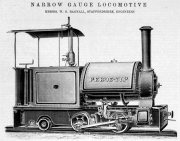
W. G. Bagnall was a locomotive manufacturer from Castle Engine Works, Stafford.
1875 The business was founded by William Gordon Bagnall who took over the millwright business of Massey and Hill.
1876 Produced their first railway locomotive. The majority of their products were small four and six-coupled steam locomotives for industrial use, and many were narrow gauge. They were noted for building steam and diesel locomotives in standard and narrow gauges.
1876 Exhibitor at the Royal Agricultural Show at Birmingham with a brick press capable of producing 20,000 per day. [1]
1879 Exhibited several Challenge horizontal engines and a small locomotive
1887 The firm became W. G. Bagnall Ltd.
1887 Private company.
1889 Steel sleepers. [2]
1889 Showed light railway plant suitable for farms and contractors at the RASE at Windsor. [3]
1891 E. E. Baguley joined the company and left in 1902 to start his own business.
1892 Around 140 locomotives had been built up to this time.
1894 Narrow gauge locomotive for 2ft gauge. Illustration in The Engineer. [4]
1914 Listed as locomotive builders and railway engineers. Specialities: narrow gauge locomotives; sugar cane, tipping and other special wagons. [5]
Bagnalls introduced several novel type of locomotive valve gear including the Bagnall-Price and the Baguley. They also used marine (circular) fireboxes on narrow gauge engines, a design that was cheap but needed a different firing technique.
Some of the designs of Kerr, Stuart and Co were brought to Bagnalls when they employed the chief Draughtsman of Kerr Stuart and Co. Examples of such locomotives can be seen on the Sittingbourne and Kemsley Light Railway.
1937 Produced the 5-hp Bagnall Demon engine but only a batch of 25 were built
1948 Heenan and Froude acquired W. G. Bagnall Ltd[6].
1951 Association formed with Brush: Brush-Bagnall Traction Ltd.
1959 W. G. Bagnall was sold to W. H. Dorman and Co, a neighbouring Stafford diesel engine maker, by Heenans in exchange for Dorman 'A' shares [7].
1961 Locomotive builders and railway engineers. 600 employees. [8]
1961 English Electric Co acquired W. H. Dorman and Co [9].
1962 New wholly-owned subsidiary formed: English Electric Traction to bring all railway-related activities under one management. These included The Vulcan Foundry, Robert Stephenson and Hawthorns and W. G. Bagnall[10].
From 1876 to 1957 the company produced 1,660 locomotives.
See Also
Sources of Information
- ↑ The Engineer of 21st July 1876 p57
- ↑ The Engineer of 19th April 1889 p329
- ↑ The Engineer of 28th June 1889 p545
- ↑ The Engineer of 23rd November 1894 p453
- ↑ 1914 Whitakers Red Book
- ↑ The Times, 27 November 1948
- ↑ The Times, 28 January 1959
- ↑ 1961 Dun and Bradstreet KBE
- ↑ The Times, 30 May 1961
- ↑ The Times, 5 May 1962
- [1] Wikipedia
- British Steam Locomotive Builders by James W. Lowe. Published in 1975. ISBN 0-905100-816

















